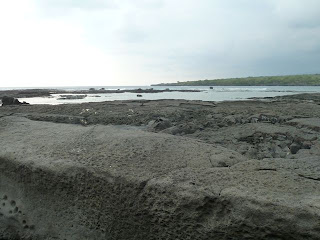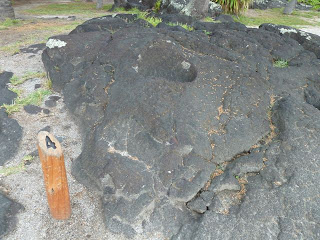Day 7 Hawaii, Kona, Thursday 22/09/2011
A beautiful morning and the top of Hualalai Volcano could be clearly defined popping though the small shroud of cloud as we drove into Alii Cove to pick up Amanda.
Amanda kept a watchful eye on us again while we did our workout at the gym - no slacking when the “De - Manda” is around! (Her gym nickname she tells us! lol)
While having our morning tea I finally got a pic of some of our garden visitors! 3 Mongoose - they loved the cat food that was put out! , one very big wild cat ( another ginger one visited earlier in the morning but missed a pic of it), and a cute little native bird!
 |
| Are you watching me!? |
We did some interesting sightseeing today and took in some of the island’s culture. We headed south from Kona, through the series of quaint little towns perched 1,000 feet above the sea - great views! ,and then from Captain Cook we went down Napoopoo Road. The road is steep and windy but worth the trip as it meanders through beautiful lush tropical vegetation and coffee farms, and has magnificent views of the coastline below.
You arrive at Napo’opo’o Beach Park on Kealakekua Bay. The bay is renowned for sighting the spinner dolphins which cruise along this part of the coast of the Big Island - they use it as their home and resting place because of the protection it provides them. The bay is also a very popular kayaking spot.
The beach at the park fronting the heiau use to be fabulous but it has been eroded away and has been replaced by boulders. In 1992 hurricane “Iniki” sideswiped the island and the surf removed most of the sand that was left.
On the shore in the park is Hiki-au Heiau, a luakini , which is a temple where human sacrifices were made.Here Captain Cook was first worshipped as the returning god Lono. It was also where the first Christian ceremony was held in Hawaii. Ironically it may have contributed to the death of Captain Cook. When one of his men died, Cook ordered him buries near the heiau and personally read the service. This event was proof to some Hawaiians that the strangers were mere mortals, not the gods others felt them to be. A mile from the beach on the north side of the bay is the Captain Cook Monument, a white obelisk erected in 1874 by the British sailors to mark where Cook was killed in1779. It is British soil! The small plot that the monument rests on was deeded to the United Kingdom by princess Likelike.
 |
| Captain Cook Monument |
The cliffs around the bay hold many secrets. Important chiefs were buried in the small caves in the cliff face. The burial person was lowered down the face of the cliff to hide the bones in crevices. When he signaled the burying was done the officials at the top would cut the rope, sending the burial person, and all knowledge of the location of the bones, crashing to the rocks below. This was considered an honour to be the volunteer at the end of the rope!
Next we drove along the coast road to the Place of Refuge, a National Historical Park. The area you drive through is where lots of blood has been spilt during many bloody battles which were a constant throughout Hawaiian history after the 12th century with rival chiefs quick to take each other on. The Place of Refuge, Pu’uhonua o Honaunau, is of great importance. In ancient times, commoner’s lives were governed by the kapu system. There were a great number of laws to observe - all manner of laws kept the order. The penalty for breaking any of the laws was death by club, strangulation, fire or spear- your choice! If the offense was severe enough, the offender’s entire family might be executed. It was believed that the gods retaliated against lawbreakers by sending tidal waves, lava flows, drought and earthquakes, so communities had a great incentive to dispatch lawbreakers with haste.If a lawbreaker could elude his club or spear-wielding pursuers, however, he had one way out of the mess - the areas Pu’uhonua (Place of Refuge). This predesignated area offered asylum.If a lawbreaker could make it here, he could perform certain rituals set by the kahuna pule, the priest, and after that all was forgiven and he could return home as if nothing had happened, regardless of the violation. Defeated warriors could also come here to await the victor of the battle. They could then pledge their allegiance to whoever won and live out their lives in peace.
 |
| The Place of Refuge viewed from the 160 rod along the coast |
 |
| The mural and story of the settlement of Hawaii and its history. Sound effects and narration great! |
 |
| Burial sites. |
 |
| A Hawaiian work structure. Below is a man in native costume making items that would be used in the village |
 |
| The leaves hanging from the roof of this work structure we re tied to a rope and used to drive fish into the hallows - a fishing method called hukilau |
 |
| Hawaiian fishing canoe |
 |
| This pond - a mixture of spring water and saltwater- held fish to be eaten by the ali'i,royalty. |
 |
| Ki'i, carved wooden images, stand watch over this reconstruction of a temple and mausoleum which housed the bones of 23 alibi, royalty. Ho'okupu, offerings, were placed the lele, tower. (See below) |
 |
| The Keoua Stone. Mark Twain reported in his Letters from Hawaii that the stone was the favourite resting place of Keoua. high chief of Kona. |
 |
| Keoua's view from his resting place! Spectacular! |
 |
| Papamu. This is an original stone used in the game of konane. (see below) |
 |
| Gathering shells to make jewellery. |
 |
| Keone'ele Cove. This cove was the royal canoe landing, forbidden to all commoners. |
 |
| Tree Mould. More than 1,000 years old, Lava from Mauna Loa surrounded everything in its path and knocked down a tree that once stood there. |
 |
| Kanoa. Bowls carved into the rock. May have been used to hold dye, evaporate ocean water to make salt, or pound 'awe. kava root to prepare ceremonial drink |
 |
| Konane. Pebbles for this traditional Hawaiian game are aranged on a replica papamu. |
 |
| Temple Model. The framework of this half-sized reconstruction of the Hale o Keawe temple is ohi'a wood tied with coconut fibre. Ki (ti) leaves were tied on as thatching. |
 |
| A communal hut. |
After leaving fascinating Honaunau we continued along the road to the charming Painted Church - St Benedict’s Catholic Church. This church dates back to the 1800’s. Between 1899 and 1904, Father John Velge dedicated himself to creating frescos on the inside walls and ceiling. Everything from hell to the Temptation of Christ is represented in his detailed frescos. Amazing! A must see when on the Big Island.
 |
| The Moggie guardian angel |
 |
| Trusting - momentos of the church with an honesty box. |
Just loved the drive today. The mountain side drive from the town of Captain Cook down to the sea at the bay was very picturesque - the lush tropical vegetation hugged the road and the flowers provided a fine show! Just beautiful!
 |
| Such a beautiful drive through the lush vegetation. |
 |
| Glorious Trumpet Trees |
 |
| Difficult to see the turkey pedestrians |
As we headed home a storm crept in but the sun was determined to have its say.
We sat in the car for 20 minutes when we arrived home while the typical afternoon downpour passed by!
This amazing island still keeps surprising us with new places to explore and enjoy! Bring on tomorrow! Beach and snorkelling day and maybe a bit boogie boarding! :) - found some in the cupboard on the back verandah!















































No comments:
Post a Comment